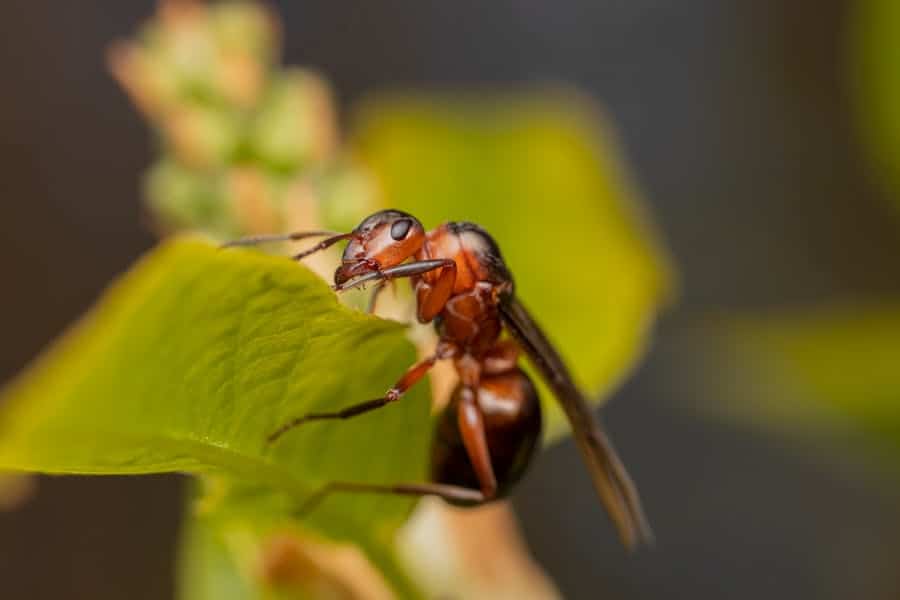The presence of winged termites, known as alates, can be a sign of potential trouble for homeowners and property owners. These small insects play a crucial role in the termite colony’s life cycle, as they are the future kings and queens responsible for establishing new colonies. Understanding what a termite looks like with wings is vital for early detection and prevention of infestations. In this article, we will delve into the physical characteristics of winged termites, explain their life cycle and emergence patterns, and discuss why it’s essential to differentiate them from other winged insects. By the end, you’ll be better equipped to identify and address this potential threat to your property.
What Does A Termite Look Like With Wings?
A termite with wings, also known as an alate, typically measures about ¼ to ½ inch in length and has a soft, cream-colored body. They have two pairs of equal-sized wings that are longer than their body. Their straight antennae and straight waist give them a distinct appearance. Winged termites are often confused with flying ants, but termites have straight antennae and a uniform body shape, while ants have bent antennae and a constricted waist.
Characteristics Of Termites
Termites are social insects known for their ability to cause extensive damage to wooden structures and are often referred to as “silent destroyers.” Understanding their characteristics is essential for effective termite control and management.
Termites are generally small insects, typically ranging from 1/4 to 1/2 inch in length. They come in various colors, including creamy white, brown, and black. Their soft bodies are segmented into a head, thorax, and abdomen, and they lack the distinct waist that ants have. Termites have straight, bead-like antennae and are often pale or translucent, making them appear almost transparent.
Termites live in highly organized colonies that can number from a few hundred to millions of individuals. These colonies consist of different castes, with distinct roles:
Workers: These termites are responsible for foraging, feeding the colony, and maintaining the nest.
Soldiers: Soldiers have large, powerful jaws and protect the colony from predators.
Reproductives: The reproductives include the king and queen, responsible for mating and laying eggs. Winged reproductive termites are called alates.
Termites are cellulose-eating insects, primarily feeding on wood and other plant materials. They have specialized gut bacteria that help digest cellulose, allowing them to extract nutrients from their food source efficiently. Termites are known for their ability to break down wood, causing significant structural damage if left unchecked.
Termites build nests that vary in structure and location depending on the species. Subterranean termites create nests underground and build mud tubes to access above-ground food sources. Drywood termites, on the other hand, establish colonies within the wood they infest, creating galleries and chambers as they consume it. Understanding the nesting habits of termites is crucial for effective pest control strategies.
Why Do Termites Develop Wings?
Termites develop wings as part of their reproductive strategy, and these winged termites are referred to as alates or swarmers. The development of wings serves several crucial purposes in the termite life cycle:
- Dispersal: The primary function of wings in termites is to facilitate the dispersal of young reproductive termites from their parent colony to establish new colonies. Once the alates mature, they leave the nest in a phenomenon known as the “nuptial flight.” During this flight, they seek out mates from other colonies, increasing genetic diversity in the termite population.
- Mating: Winged termites from different colonies come together in the air during the nuptial flight. They engage in mid-air mating, where males and females pair up. After mating, they shed their wings and search for a suitable location to start a new colony. The male and female termites become the king and queen of the newly founded colony.
- Colony Establishment: Once the mated pair lands, they become the foundation of a new termite colony. They dig into the soil, build a chamber, and begin laying eggs, kickstarting the growth of a new termite community. The wings, which served their purpose in the nuptial flight, are no longer needed and are shed after landing.
How To Differentiate Termite Alates From Other Winged Insects?
Differentiating termite alates (winged termites) from other winged insects, such as flying ants, can be challenging but is essential for proper pest identification. Here are some key characteristics to help you distinguish between the two:
Antennae:
- Termites: Alates have straight, bead-like antennae that do not have the distinct elbow bend.
- Flying Ants: Ants have elbowed or bent antennae, which are a noticeable feature when observing their head.
Body Shape:
- Termites: Alates have a uniform, thick-waisted, and broadly segmented body. Their body shape is relatively straight and lacks the distinct constrictions found in ants.
- Flying Ants: Ants have a more defined waist with a noticeable constriction between the thorax and abdomen, giving them an hourglass-like shape.
Wing Characteristics:
- Termites: Alates have two pairs of wings that are equal in size and shape, and these wings are typically longer than their body. Termite wings are translucent and often have a uniform size.
- Flying Ants: Ants also have two pairs of wings, but the front wings (forewings) are larger than the hind wings (hindwings). Ant wings are typically not as long as those of termites, and the forewings are more prominent, extending beyond the abdomen. Additionally, ant wings are often uneven in size, with larger forewings and smaller hindwings.
Color:
- Termites: Alates are usually pale or translucent, with colors ranging from creamy white to light brown or black.
- Flying Ants: Ants can vary in color, but they often have a darker and more pigmented appearance compared to termites.
Behavior:
- Termites: Termite alates are primarily seen during the nuptial flight, when they are swarming to find mates. They are not typically found foraging for food in the same way worker termites are.
- Flying Ants: Flying ants may be observed foraging for food, and they are more commonly seen outdoors in search of food sources.
Wing Shedding:
- Termites: After the nuptial flight and successful mating, termite alates shed their wings, and you may find discarded wings near potential nesting sites.
- Flying Ants: Ants do not shed their wings after mating, so you are less likely to find discarded wings in their vicinity.
Preventing And Managing Winged Termites
Preventing and managing winged termites (termite alates) is essential to protect your property from potential infestations and damage. Here are some effective strategies to prevent and manage winged termites:
- Maintain Proper Ventilation And Moisture Control: Termites are attracted to moisture, so ensure that your home has proper ventilation and moisture control in basements, crawl spaces, and attics. Fix any leaks promptly and ensure good drainage away from your home’s foundation.
- Eliminate Wood-To-Soil Contact: Termites can easily access your home through direct contact with soil. Remove any wood-to-soil contact, such as wooden stakes, debris, or tree branches touching your home.
- Use Termite-Resistant Building Materials: When building or renovating, consider using termite-resistant materials like treated wood or concrete for structural components.
- Regular Inspections: Conduct regular inspections of your property for signs of termite activity, including mud tubes, damaged wood, or discarded wings after a swarm.
- Maintain Your Landscape: Trim trees and shrubs away from your home to prevent termite access via branches or roots.
- Termite Barriers: Consider installing physical termite barriers like metal mesh or termite shields during construction or renovations.
- Professional Pest Control: Consider hiring a licensed pest control professional for regular termite inspections and treatments, especially in areas prone to termite infestations. Professionals can use various methods, including liquid termiticides, baiting systems, and physical barriers, to manage termite populations effectively.
- Baiting Systems: Termite baiting systems can be used as a preventive measure. These systems use bait stations placed around your property to attract and eliminate termite colonies.
- Remove Dead Wood And Debris: Remove dead trees, stumps, and wood debris from your property, as they can attract termites.
- Educate Yourself: Learn about the types of termites common in your area, their behavior, and the signs of infestations to be better prepared for prevention and management.
Conclusion
In conclusion, understanding what a termite looks like with wings and implementing preventive measures is vital for safeguarding your property. By recognizing the distinctive characteristics of termite alates and staying vigilant, you can detect potential infestations early. Effective prevention strategies, such as moisture control, regular inspections, and professional pest control assistance, can help mitigate the risk of termite damage. Remember that termite management is an ongoing process, and staying informed and proactive is key to preserving your home and property from these silent but destructive pests.








